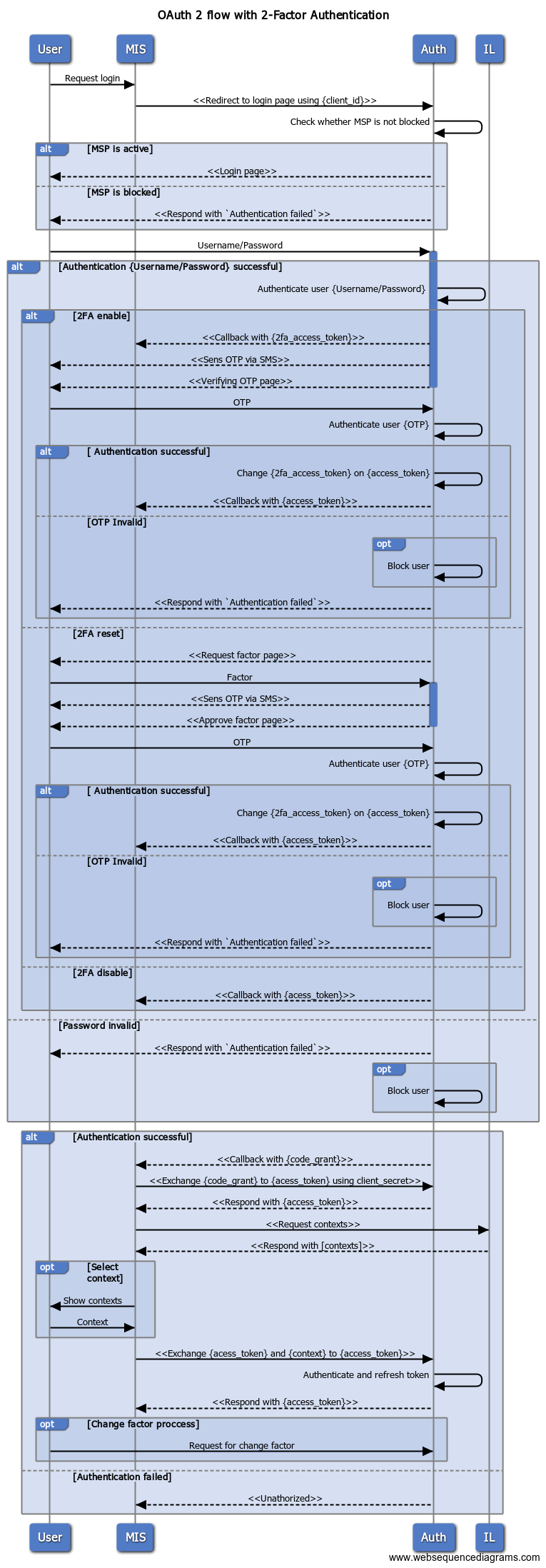ЕСОЗ - публічна документація
Auth
General description
Authorization module performs access control to the eHealth resources. Protected objects - REST endpoint + method
For example:
GET /api/legal_entities
POST /api/employee_requests
POST /api/employee_requests/:id/approve
Auth module doesn't take into attention the exact instance of the resource. It stops on the resource type level.
For example `POST /api/employee_requests/:id/approve`. Auth will check whether user can approve employee_requests in general, not the particular :id of employee_request.
Protection levels
| Level | Description |
|---|---|
| no protection | some endpoints are not protected at all. In this case auth is not used. User→>eHealth system-->>eHealth For example: GET /api/dictionaries GET /api/uaddresses/regions |
| direct access | Is used to access resources directly without MIS brokers. User-->>eHealth System will check whether user has access to the requested resource. access_token with the proper scope is required to access resource for example, endpoints that are used by the NHS admin: GET /api/innms |
| broker access | Is used to access ehealth resources via MIS providers User-->>MIS-->>eHealth access_token with the proper scope is required MIS api-key with the proper broker_scope is required Most of the endpoints are protected with this level |
| api-key access | Is used to access ehealth resources by other systems (clients). For example - MISes. No user token is required. MIS→>eHealth List of endpoints: GET /api/events/id GET /api/events POST /api/legal_entities |
Functional requirements
Authentication
The system should allow a user to:
- Login to the system using a user name and password
- Retrieve a missing password
- Change a password
- Authorize with 2-factor authentication
- Change factor for 2-factor authentication
The system should allow a system administrator to:
- Create user accounts, including login name, password, and appropriate roles and permissions
- Activate and deactivate user accounts
- Set time boundaries to user accounts (e.g. 06/08/09-08/14/09 for summer interns)
- Manage users 2-factor authentication
Roles and Permissions Requirements
The system should allow authorized users to:
- Provide security for different levels of user, e.g. Owner, HR, Doctor, Accountant, etc.
- Define security at the function level, e.g. allow a user to access data entry functions only.
- Restrict certain functions to authorized personnel only, e.g. certain user group has read-only access, another user group has ability to modify data.
OAuth 2 Flow (with 2-Factor Authentication ) is used
Source file for diagramm: OAuth 2 flow.txt
{client_id} and {client_secret} is generated for each MIS during registration process
- MIS: Request login page using {client_id}
- eHealth: Check whether MSP with {client_id} is not blocked (is_blocked=false)
- in case of error return 401 error: 'Authentication failed'
- User: Log in to eHealth using username/password
- eHealth: Callback to MIS with {code_grant}
MIS: exchange {code_grant} to {access_token} using {client_secret}
{access_token} has grants to get_contexts, set_context only
MIS: request available user contexts (list of MSP) via get_contexts
- MIS: Set current user context via set_context and exchange {access_token} according to current context
- eHealth: Respond with new {access_token} according to current context
Auth flow implementation
Auth ERD
Erd file in repository : https://github.com/edenlabllc/mithril.api/blob/master/specs/mithril.erd
users
roles
Dictionary of user roles. Whenever new role is added in this dictionary, it should be implemented and supported in the system.
In PRM User_role is mapped to the employee_type.
| role |
|---|
| ADMIN |
| MIS USER |
| UADDRESSES ADMIN |
| MITHRIL ADMIN |
| NHS ADMIN |
| OWNER |
| DOCTOR |
user_roles
Links between users and roles. Role can be assigned only within some client context
clients
List of clients, registered within the system
client_types
dictionary of client types. Whenever new role is added in this dictionary, it should be implemented and supported in the system.
Mithril will not allow client to request scopes that are not listed in the client_types.scope
Currently there are below client types:
| Client_type | Purpose |
|---|---|
eHealth_Auth | Auth frontEnd |
| MSP | Medical service provider |
| MIS | Medical information system |
| NHS_Admin | Admin console of the NHS |
| Auth_Admin | Admin console of the Mithril itself |
Auth flows may work differently based on the client_types:
1) TOKENS_TYPES_ADMIN - Results are filtered by the request parameters if any, client_id from token is ignored
2) TOKENS_TYPES_PERSONAL - Results are filtered by the request parameters if any, only records that belong to client_id from the token will be returned
3) TOKENS_TYPES_MIS - Results are filtered by the request parameters if any, only records that are created by client_id from the token will be returned
It is configured in the environment variables
tokens
Related content
ЕСОЗ - публічна документація

